February 25, 2015
By P.J. Reilly
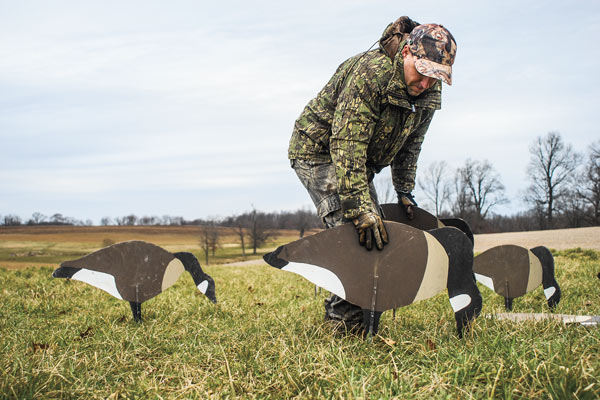 Sean Mann is a silhouette guy. And his explanation is simple for sticking with the flat fakes, while the honker-hunting world is going full-body crazy.
Sean Mann is a silhouette guy. And his explanation is simple for sticking with the flat fakes, while the honker-hunting world is going full-body crazy.
"They work."
The veteran callmaker, former world-champion caller and longtime hunting guide remembers well when he gave up on full-bodies and shells. It was several years ago, while he was guiding a party in Alberta. The squad had planted a full array of shells, full-bodies and silos in a pea field that held a fine smattering of Canadas the day before.
Just as the sun was starting to make the prairie glow gold, the wind died and Mann's stake-mounted full-bodies and shells quit dancing. Dew started to accumulate and his decoys shined. Incoming flocks circled nervously overhead, but they didn't like what they saw and all flew by.
Advertisement
"One of my guides told me the decoys were shining, and, for once, I listened," Mann said. "I told him to go get the trailer, and I told the hunters to pull every shell and full-body, but leave the silos alone. We loaded up, and before my guide had parked the trailer, we had geese landing in the silhouettes."
Arguably the one-time king of the decoy world for Canada goose hunters, silhouettes are making a comeback across North America. Whether waterfowlers are discovering them for the first time, or switching back after a hiatus, the 2-D decoys are showing up in more and more fields. So we decided to pick the brains of two silhouette diehards — Mann and Jim Slotterbeck, waterfowl specialist for Real-Geese (the authority on the flat fakes) — to unlock the doors to silo success.
Seeing is Believing
Advertisement
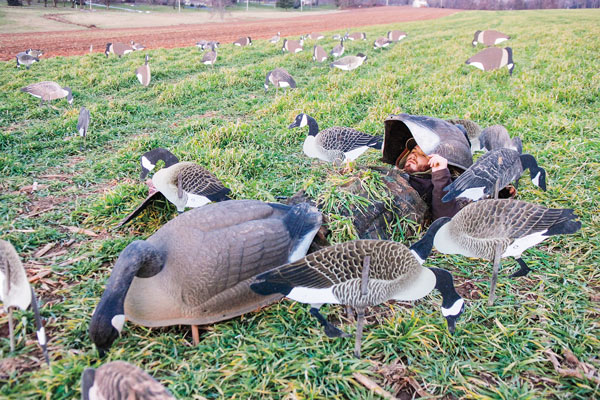 Both Mann and Slotterbeck were quick to note they don't believe shells and full-bodies are bad decoys. They're just strong believers in the benefits they see in silhouettes. And at the top of their benefit list is visibility.
Both Mann and Slotterbeck were quick to note they don't believe shells and full-bodies are bad decoys. They're just strong believers in the benefits they see in silhouettes. And at the top of their benefit list is visibility.
"Silhouettes have a higher profile," Slotterbeck said. "Full-bodies, and certainly shells, can get lost in the ground clutter, but silhouettes always sit up nice and tall."
And when the sun is shining, Mann said, the two-dimensional profile pays off doubly.
"They cast a great shadow that other decoys don't," he said. "Geese fly over and they see the decoy itself, but then they see this black shadow. And think about where goose hunters hunt. We're in green fields early in the season, and then in the late season, everything is light beige. Black shows up great in both those settings."
More Mobile
The two honker nuts are big fans of the ease with which silos can be transported.
"I can get three-dozen Real-Geese into one bag that basically takes up the same amount of space as one full-body," Mann said. "So if I take four bags, I can get 12-dozen decoys into the trunk of a Toyota Corolla if I have to, where I'd need a trailer to take that many full-bodies."
Slotterbeck annually hunts honkers in the flat, fertile farm country of Ohio. Flat farm fields get wet and sloppy in goose season. The birds love it. Trailers don't always fare so well. And even if they can, many farmers won't allow them.
"We hunt a lot of places where the farmers will give us permission to hunt, so long as we promise not to drive in their fields," he said. "If we're hunting with four guys, each guy can take a bag of silhouettes, their layout blind, shotgun and shells, and we can walk out to any spot in the field with 12-dozen decoys and all our gear — no problem.
"I used to have a trailer and an ATV, but I sold them years ago. With silhouettes, I have no need for them."
Also, once Slotterbeck takes a new set of Real-Geese silos out of the box and attaches the stakes, they're always ready to hunt.
"You never have to mess with putting on and taking off heads or feet," he said. "You take them out of the bag and stick them in the ground. That's it."
Still Moving
Several times over the course of his career, Mann has had eagles and coyotes attack his decoys. But they've only hit his silhouettes and his stuffers.
"That, right there, tells me all I need to know about how realistic my decoys look," he said. "If they're fooling a coyote, they must look real."
Commercial silhouette manufacturers generally offer a wide variety of decoy poses. If you have a dozen each Real-Geese Pro Series, Pro Series II and Pro Series Sit 'N Geese decoys, for example, you'll have 30 different poses among your 36 decoys. If you make your own silhouettes — a wildly popular endeavor among honker hunters on Mann's native Eastern Shore of Maryland — then the sky's the limit for the number of poses you can have.
"I think geese pick up on the fact that they're looking at the same five or six poses when they look at a spread of full-bodies," Slotterbeck said. "It doesn't look as natural as a spread where the decoys have a lot of different looks."
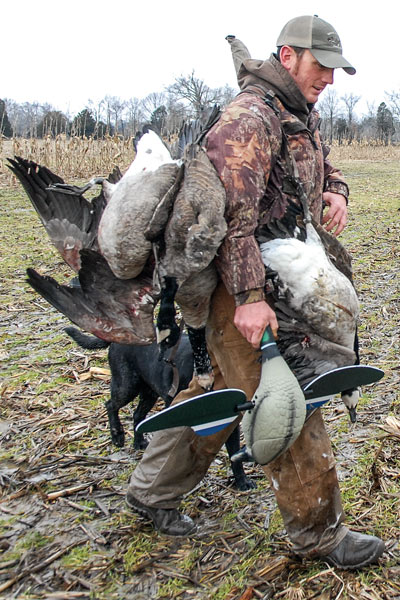 And while full-bodies and shells need wind to create motion, silhouettes look like they're moving when they're standing still. As a flock of birds in the air circles around a spread of silhouettes, their view of individual decoys will constantly be moving from the broad side to the thin edge and back again. When the broad sides of decoys go in and out of view, it creates the illusion of motion.
And while full-bodies and shells need wind to create motion, silhouettes look like they're moving when they're standing still. As a flock of birds in the air circles around a spread of silhouettes, their view of individual decoys will constantly be moving from the broad side to the thin edge and back again. When the broad sides of decoys go in and out of view, it creates the illusion of motion.
"And you don't have to have wind," Mann said.
Mann noted that goose hunters on the Eastern Shore have been killing honkers that get tons of pressure over homemade plywood decoys painted simply black and white.
"I think it's the poses, the shadows, the tall profiles and the perceived motion combined that makes them look so real to live birds," he said.
Shine is a complaint some hunters have about silhouettes. The flat, slick surface provides the best conditions for glare, especially if the decoy is wet. Slotterbeck said Real-Geese has taken steps to eliminate glare on its decoys with non-reflective finishes.
Mann said shine isn't the problem hunters think.
"Hunters see glare because they're looking at decoys from the ground," he said. "From the air, a bird's perspective is different. They're looking down on the decoys. Assuming the decoys are set right, at worst, when the sun is low on the horizon, the sun should be reflected straight out, parallel to the ground. A goose in the air isn't going to see that."
In a world where full-bodies are so popular, Slotterbeck said silhouettes can be more attractive simply because they're different.
"We hunt one part of Ohio where there are a lot of birds and a lot of hunters," he said. "I've driven down the road and all the full-body rigs look essentially the same. A silhouette rig in that area stands out. And that's what you have to do to get pressured geese to come to your field."
Spread 'Em Out
While we're on the subject of realism, Mann and Slotterbeck stressed the need to keep plenty of distance between your silhouettes to get the full effect of their realism. It does no good to have them partially covering one another because they are packed so tightly.
"My motto has always been, 'When in doubt, spread 'em out,'" Mann said.
Having good spacing between each silhouette means there's plenty of room for geese in the air to see decoys transition from broad side to thin side. It also means shadows don't meld into an indistinguishable mass of black. Each decoy and its shadow are clearly visible to live birds in the air.
Mann directs hunters in his parties to take five to seven steps between each decoy placement. Slotterbeck's rule is three steps.
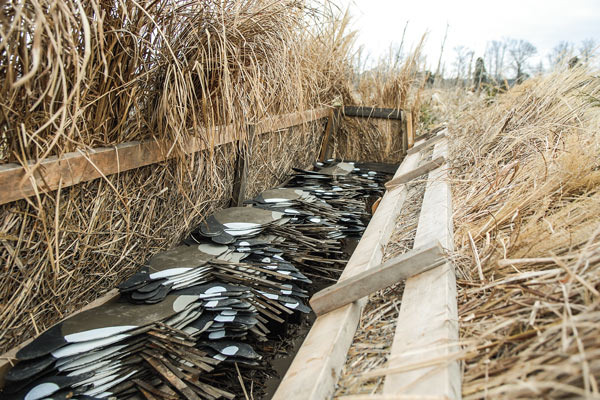 Mann acknowledged his distance requirement encourages birds to land in places within the rig that might not be advantageous for shooting. A pair might lock in on a gap that's behind the line of hunters, for example.
Mann acknowledged his distance requirement encourages birds to land in places within the rig that might not be advantageous for shooting. A pair might lock in on a gap that's behind the line of hunters, for example.
"I'll take that risk," Mann said. "As long as they're coming in and landing, we'll get some shooting."
Even though he likes to spread his decoys way out, Mann said he always makes sure he keeps them all within shotgun range. He's had hunters walk out into the rig to flush geese that landed in a spot where they couldn't be shot on approach.
"That's a good way to get those singles and pairs," he said.
How Many?
Slotterbeck generally follows a rule of planting three-dozen decoys per hunter in the field. That's one bag of Real-Geese per man, a simple pattern he's employed successfully. There are, however, exceptions.
In some places where Slotterbeck hunts, the roosting waters are small and spaced out. Consequently, flocks are small and spread out.
"If we're hunting a field that only has 50 or 60 birds using it, we're not going to put out 150 decoys," he said. "We'll back it off to three- or four-dozen. But if we're hunting up by Lake Erie, where there are a lot of big refuges and birds are flying around all over the place, we'll go with a bigger spread."
In those places with lots of birds, Slotterbeck said he won't go with less than 12-dozen decoys, regardless of how many hunters are in his party.
"If there are only two of us, I'm not going to back off my decoy numbers," he said. "You still have to be effective."
Mann's magic number typically is 12-dozen as well.
"That's just a number I've found through experience works well for me," he said. "I always say, I don't consider myself to be smarter than other hunters, but I've just had the opportunity to see a lot more than a lot of hunters."
Mann has hunted hot fields with just a couple dozen decoys, but he acknowledged such hunts are more about being in the spot where the geese want to be. If you're running traffic, then it's a different game. You need numbers to attract geese from their intended destination to your field.
"If I'm going to err, I'm going to do it on the side of having too many rather than too few," Slotterbeck said.
Figuring out what's too many and what's too few comes with experience, because those figures vary among different areas. The number of geese you're playing with and the amount of pressure flocks experience both are key factors that affect spread size.
Deploying the Dekes
After agreeing on providing plenty of space between their decoys, Mann and Slotterbeck take somewhat different approaches to setting their silhouette rigs. Mann is famous for arranging his decoys in an X. That's the shape he prefers when he's hunting from layout blinds or a pit.
"That gives the geese four landing zones," he said. "Let them decide which one they want and then, if you're in layouts, you can adjust your blinds accordingly."
Mann's penchant for putting lots of room between his silhouettes works well with an X pattern.
"When you have one to three or four birds coming in, they almost always land in the decoys," he said. "It's when there's five or more that they'll land in the spaces created by the X shape."
And it's the birds that land in the decoys that Mann wants most. He never shoots at monster flocks, because he believes all that does is kill a few and educate a lot more. Birds that touch down in the decoys are geese that are close and relaxed.
"They're the easiest to kill," he said.
When the decoys are bunched, the small groups tend to land outside the rig.
"You see it all the time with tight rigs," he said. "The birds will work and work to land in the decoys, but then they'll slide outside when they can't find a spot."
The exception to the X, Mann said, is when he's hunting from cover, such as a tree line or fencerow. Then he'll arrange his decoys in a V shape.
"All it is is half an X," he said. "Everything else is the same."
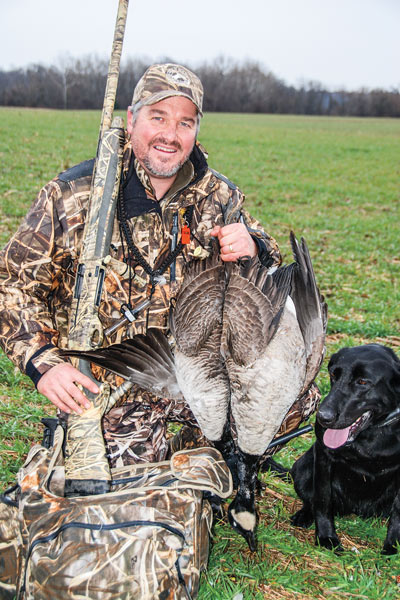 Slotterbeck favors a rig in the shape of the Nike swoosh. He'll set the shape so that the wind is blowing straight out of the hook, which means the geese will land into it. But unlike a lot of hunters, he doesn't put his blinds in the hook facing out. He shifts them off to the side so that the geese are landing cross-wind in front of the hunters.
Slotterbeck favors a rig in the shape of the Nike swoosh. He'll set the shape so that the wind is blowing straight out of the hook, which means the geese will land into it. But unlike a lot of hunters, he doesn't put his blinds in the hook facing out. He shifts them off to the side so that the geese are landing cross-wind in front of the hunters.
"I think geese are onto the layout blinds," he said. "We still use them, but I don't want landing birds looking right at the blinds."
When he sets his silhouettes, Slotterbeck makes sure more than half are broadside to the area where he expects the geese to land.
"That's the best look they can get at a silhouette, so I want them to see lots of geese feeding — which is what the live birds are looking to do too," he said.
Slotterbeck also makes sure he's got a healthy number of silhouettes broadside to the direction from which he expects geese to approach.
"This is where scouting is so important," he said. "If you've got geese skimming over a tree line, you want to catch their attention with a good number of broadside decoys. Then, when they start to work, they'll swing around and get the view of decoys coming in and out of view. To them, it looks like geese moving around as they feed, which is what they're expecting to see."
Silhouettes have been around for a long time. And if you're tired of hauling dozens of full-bodies to pressured fields with minimal results, there's no harm in trying something different, especially if everyone around you is running the same rig.
"When you think about it, they haven't really changed all that much," Mann said. "I don't care what it is, if it's been working for this long, I want to have it."
Slotterbeck encouraged hunters who have seen other types of decoys lose their magic to give silhouettes a try.
"They're light, they're easy to work with and they're effective," he said. "What more could you want?"
